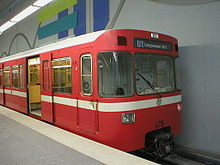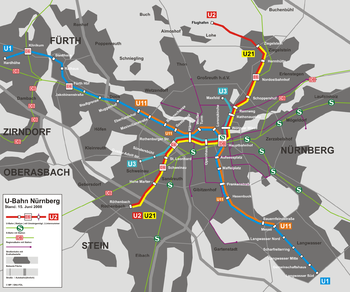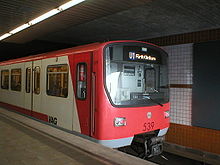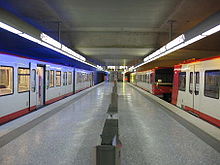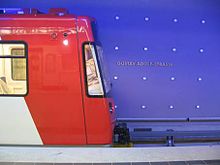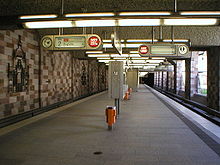- Nuremberg U-Bahn
-
Nuremberg U-Bahn 
Info Locale Nuremberg Transit type Rapid transit Number of lines 3 Number of stations 44 Daily ridership 316 000[citation needed] Operation Began operation 1972 Operator(s) VAG Nürnberg Technical The Nuremberg U-Bahn is a metro run by VAG Nürnberg (Verkehrsaktiengesellschaft Nürnberg or Nuremberg Transport Corporation), which itself is a member of the VGN (Verkehrsverbund Großraum Nürnberg or Greater Nuremberg Transport Network). The Nuremberg U-Bahn is Germany's newest metro. Its DT1 vehicles are largely the same design as the A cars found on the Munich U-Bahn, and both transport companies once lent each other trainsets as reserve rolling stock for major events (such as the Munich Olympics) at the time when both systems were quite new. Such swaps are now no longer possible, as the rolling stock on each system has developed in ways that would require it to undergo modification for use on the other system. The newer Nuremberg trains (the DT2, for example) are incompatible with the Munich system.
Contents
History
On 20 March 1967, German transport minister Georg Leber and Nuremberg Oberbürgermeister ("Lord Mayor") Dr. Andreas Urschlechter had the honour of "striking the first blow" for the new metro. This was done in Bauernfeindstraße when they triggered the pile driver.
On 1 March 1972, the first 3.7 km-long (2.3-mile) stretch of the system opened, U1 Langwasser Süd <> Bauernfeindstraße. Over the next few years, further stretches of U1 were opened.
On 28 January 1984, Nuremberg's second U-Bahn line went into service between Plärrer and Schweinau. This line, too, underwent further extensions, eventually even reaching the airport.
In 2004, 6 Munich A cars were bought by VAG to supplement its own rolling stock fleet. However, owing to the divergence in specifications between the Nuremberg and Munich systems, it turned out that the old Munich stock could not be coupled with Nuremberg stock. As a result, it was not possible to compose trains using both types, although they can at least run on the same tracks. VAG left the Munich stock in its old white and blue Munich livery, reasoning that it was not worth repainting in Nuremberg livery, given that it was approaching the end of its service life.
On 4 December 2004, a new 1.3 km (0.81 mi) section of U1 opened in Fürth, stretching from Stadthalle station to Klinikum station.
On 8 December 2007, U1 was further extended to Fürth Hardhöhe.
Network
The route network comprises about 34.6 km (21.5 mi) and 44 stations which can all be reached by lift, something that makes the system unique in Germany. Another thing that makes this system special is the use of "firm track" (i.e. with rails fastened to a solid trackbed, rather than to sleepers on ballast) in almost all tunnels, although not at Langwasser Mitte (U1) and the adjoining tunnel up to just before Gemeinschaftshaus. Also, ballast is still found, but only on the inbound track, at the entrance to Schoppershof station (U2).
Line Route Opened Length Stations U1 Fürth Hardhöhe ↔ Langwasser Süd 1972–2007 18.5 km (11.495 mi) 27 U2 Flughafen/Airport ↔ Röthenbach 1984–1999 13.2 km (8.202 mi) 16 U3 Gustav-Adolf-Straße ↔ Maxfeld 2008 6 km (3.728 mi) 9 U1
Fürth Hardhöhe <> Langwasser Süd
Within Fürth there are seven U-Bahn stations: Stadtgrenze (partly within Nuremberg, partly within Fürth – indeed the station's name means "city boundary" – but assigned to and run by Nuremberg), Jakobinenstraße, Fürth Hauptbahnhof, Rathaus, Stadthalle, Klinikum and Hardhöhe.
The planned extension to Kieselbühl is now in question, because the expected developments in this area are behind schedule.
U2
Nuremberg Airport <> Röthenbach
The airport connection makes Nuremberg the only city in Germany with a direct subway link to its airport, some other cities have urban rails linking their airports to the city, like Berlin (Schönefeld Airport/Berlin-Brandenburg International Airport under construction), Munich, Stuttgart, Frankfurt, Düsseldorf, Hamburg, Dresden, Leipzig and Cologne, other have tramways, like Bremen and Erfurt.
Some of the more newly built stations are rather artistically designed. Especially worth seeing are the following stations:
- Rathenauplatz - anamorphic tile mosaics with portraits of Walther Rathenau and Theodor Herzl
- Hohe Marter - tile mosaic of the broadcasting tower
- Rennweg - graffiti
In 1984, line U2's new Plärrer–Schweinau stretch began operations. At first the trains ran by day as line U21 (not to be confused with the current U21) by way of Weißer Turm and Lorenzkirche to Aufseßplatz or Langwasser Süd. Since 1988, the line has run as U2 by way of Opernhaus to Hauptbahnhof (Nuremberg Main Railway Station). After further extensions in 1990, 1993 and 1996, U2 reached its current terminus at the airport in 1999.
In September 2009 the first driverless trains ran in passenger service on line U2. Four out of the eight trains in service on the line moved to automatic control, with the aim of full automation by January 2010.[1]
U3
Gustav-Adolf-Straße ←→ Maxfeld
The latest U-Bahn line U3, was opened on 14 June 2008. This line uses the U2 tunnel between Rathenauplatz and Rothenburger Straße and diverts north of Rathenauplatz to the northwest and south of Rothenburger Straße to the southwest of Nuremberg. The U3 line has fully automatic operation without drivers.
On 30 October 2008, the first accident resulting in a death occurred at Rathenauplatz station. A passenger fell onto the track as a train approached the platform. The train was unable to halt in time because of the short distance to the fallen passenger and limitations of its braking system. Even if the same incident had occurred with a manually operated train, the driver would not have been able to halt in time, either.
Each of the stations along U3 route has tubes resembling yellow fluorescent light tubes running the length of the platform. These tubes emit radar waves and monitor the track for any fallen obstacles. If an object or person falls into the track, automatic brakes on trains are triggered.
Verstärkerlinien ("Booster" Lines)
To increase passenger capacity on the central parts of the subway, additional trains are scheduled which reverse before the line terminus and run only the central areas of Nürnberg. To reduce passenger confusion these trains are assigned a different line designation (line number):
Line Route Opened Length Stations U11 Eberhardshof ↔ Messe 1972–2007 8.1 km (5.033 mi) 14 U21 Röthenbach → Ziegelstein 1984–1999 11.0 km (6.835 mi) 15 U11
U11 service runs on the U1 line between Eberhardshof and Messe most of the day, adding passenger capacity between Nürnberg main station, the car-free main shopping district and the Plärrer.
U21
U21 trains run only from Röthenbach to Ziegelstein on the U2. Since the single-tack tunnel between Ziegelstein and Flughafen ("Airport") can only accommodate a train frequency of 400 seconds (one train every 6 2/3 minutes), only every second train during the day runs to Flughafen, with trains in between reversing at Ziegelstein. On the way back all trains are designated as U2 since they all run to Röthenbach, and therefore indicating whether trains originated from Ziegelstein or Flughafen is meaningless to passengers.
Further extensions
U3 Nord (Northern branch)
The northern branch (U3 Nord) diverts from the U2 tunnel north of Rathenauplatz to run west under the northern quarters of Nuremberg. This branch will consist of 5 stations, of which only a single station (Maxfeld) has been completed to date. Another two stations (Kaulbachplatz and Friedrich-Ebert-Platz) are under construction and scheduled to open in 2011. The last two stations (Klinikum Nord and the terminus station Nordwestring) are expected to open around 2013, thus completing this branch.
U3 Süd (Southern branch)
The southern branch (U3 Süd) diverts from the U2 tunnel south of Rothenburger Straße and runs to the west as well. Two stations of this branch (Sündersbühl and Gustav-Adolf-Straße) have been completed. The precise alignment of this branch and the location of further stations after Gustav-Adolf-Straße are still to be determined. The terminus of this branch, to be opened around 2013 or later, will be Gebersdorf Nord near the station Fürth Süd, a former station of the abandoned Bibertbahn railway at a busy street intersection south of Fürth's city limits. Further expansion beyond is under consideration on the right of way of the abandoned Bibertbahn railway into Zirndorf and possibly beyond.
DT3 units
Thirty new train units (named DT3) were ordered and have been delivered for U3 operations. Those trains are designed to operate without a driver, controlled by an ATC system from Siemens, and will provide the passengers with an unobstructed view from the front window into the tunnel. A normally locked drivers panel exists at every front window which enables service employees to drive DT3 units by hand if required. As with all Nürnberg subway trains, these units consist of two carriages and are half the platform length. They can be run as a single unit (short train) or coupled as double unit (long train), depending on passenger numbers. For the first time in a Nürnberg subway train, the two carriages of a unit are built with an accessible gangway. This is intended to improve passenger distribution in the train as many stations in the system have their exits at the very ends of the platform and therefore often the first and the last carriages of a 4 carriage (long) train are rather full, while the two middle carriages are relatively empty.
ATC and driverless trains
The ATC system is derived from Deutsche Bahn's Linienzugbeeinflussung (LZB), with additional parts added for door control and other safety systems. It works by transmitting data from the train to the interlocking station through two cables installed in the track between the rails. About one year after the U3 line has entered service, it is intended to convert U2 line to full ATC operations; however, during the first year there will be mixed traffic of ATC-run driverless DT3 units on U3 courses and coventionally run DT1 and DT2 units on U2 and U21 courses between Rathenauplatz and Rothenburger Straße. This has not been done anywhere before and therefore the ATC system had to be specifically designed and developed to allow for this mixed operation mode. All train operations will be automated, including normal operation, coupling and uncoupling of two DT3 units in storage tracks as well as at platforms, moving trains from and to storage tracks as well as reversing trains at platforms and in storage tracks.
Day-to-day operations will be handled rather like those of Docklands Light Railway, with service employees riding in some trains to watch out for disruptive passengers and unusual occurrences and to supply information to passengers. Unlike the DLR however, not every train will be accompanied by a service employee, and again unlike the DLR, service employees have no task in the actual operation of the train. Doors close automatically, supervised by light barriers and pressure-sensitive door edges. Only in the case of service disruptions will a service employee take over the task of driving the train. For this purpose, all service employees are fully trained drivers.
There were many reasons for choosing an automated, driverless system:
- First was the demand to reduce operation cost by eliminating the driver. There will be no layoffs even after the full conversion of the U2 line to ATC operations, since existing drivers will be trained as service employees, but no new personnel will be hired for the operation of the new line. VAG expects to improve line safety and passenger satisfaction by this change, since former drivers who were behind a door and busy with the operation of the train are now becoming service employees. They now become available to passengers inside the carriages and on platforms to look out for disruptions and possible crime, thus increasing the subjective security, and to supply information and answer questions, helping passengers find their way.
- Another reason was the improved capacity of the U2 tunnel that was needed to accommodate the U3 traffic. Current subway lines in Nürnberg are built for a train frequency of 200 seconds or 3 1/3 minutes (sole exception: Ziegelstein-Flughafen: 400 seconds), which is already fully used on the U1 during the day and on the U2 during morning rush hour. With the new ATC system in place, additional (virtual) blocks will exist between stationary block signals, thus increasing line capacity to a train frequency of 100 seconds. However, these new blocks can only be used by ATC-operated trains since they are virtual and have no stationary signal associated with them that can be observed by a driver-operated train without ATC equipment. Thus the increased line capacity can only be effectively used after the U2 has been converted to full ATC operation.
- For the creation of a new ATC system accommodating mixed ATC and non-ATC traffic federal grants and subsidies were awarded, offsetting some of the additional cost.
- ATC-controlled trains in storage tracks can be activated instantly, making it possible for the line controller to put additional trains into passenger service at a moment's notice when he observes unexpected increases in passenger numbers.
Passenger Safety
All DT3 units are equipped with passenger intercom panels near every door in addition to the standard emergency brakes and emergency door release handles. Controllers can access CCTV cameras in every unit from the control centre through a Wireless LAN link installed in all tunnels that are used by DT3 trains. Flame-retardant materials are used wherever possible. Temperature sensors and smoke detectors are spread throughout every unit in the passenger space and in every underfloor machinery compartment to detect possible fires as early as possible. Circuit integrity retaining cables (cables that can keep their insulation for a certain time in the presence of fire) are used to allow a unit to proceed to the next station in case of a fire. German regulations mandate that all subway trains must not stop inside a tunnel after the emergency brake has been pulled or if any other hazard like a fire is detected, but instead should proceed to the next station if possible to ease rescue operations. Since the longest travel time between two stations on the Nürnberg U-Bahn is about 3 Minutes (between Ziegelstein and Flughafen) and most stations are less than 60 seconds apart, this is deemed a superior option to stopping inside a tunnel, where evacuation, rescue and firefighting attempts would be much more difficult than on a station platform.
German regulations mandate some means to stop a train if a person or large object should fall onto the track. Installing doors between track and platform (like on Paris's Météor Line) would have been the superior solution, but since 6 stations which were already in full operation (the section Rathenauplatz to Rothenburger Straße) needed to be converted, fitting doors to the platform edges would have led to severe service disruptions and station closures. Another problem would have been that the conventionally run trains would have had to be stopped within an area of a few centimeters by the driver, which would have been difficult. Therefore, platform doors were out of the question. After tests with laser light barriers (from the station ceiling to the platform edge) at Plärrer, a combination of CCTV cameras overlooking the track bed and radio frequency barriers between from under the platform edge to the opposing wall were chosen and installed at all stations serviced by U3. The RF barriers will detect persons and objects falling onto the track. In such a case the ATC will stop any approaching trains on that track immediately and alert the control centre, from where an operator can visually inspect the trackbed at the platform over CCTV and then take the appropriate action.
Technical Problems leading to a 2-year delay
Construction of the line started in 2003, with the DT3 units ordered in the same year, and opening of the initial line segment from Maxfeld to Gustav-Adolf-Straße had been schedued for early 2006.
Initially it was thought by Siemens and VAG that development, testing and certification of the ATC components could be conducted during those 3 years in parallel to the construction of the line, at first in simulations and, after the first DT3 units had been delivered, on a test track at the Langwasser Depot, and that the new line could enter service immediately after the tunnels and stations were built. However in 2005 news was published that ATC development was not progressing as planned and that the opening would have to be postponed by one year to late 2006 or early 2007. In fall 2006 the responsible parties had to admit that the ATC system would still not be ready by the already postponed date at the end of 2006 and that the opening of the line would have to be postponed again. At that point, Siemens appointed a new project manager. As of July 2007, the official opening date is touted to be at the end of April 2008, with the 3-month passengerless full operation phase mandated by German law being conducted sometime in winter 2007, and a phasing in of passenger service in several steps starting in January 2008.
To Siemens this delay is a major embarrassment, since the company hopes to sell this ATC system to other subway operators around the world who wish to gradually convert their existing subway lines to ATC operation, allowing for mixed operations on line segments used by ATC and non-ATC operated trains during interim periods.
Fürth Kieselbühl
Plans for another station after Hardhöhe exist under the name Fürth Kieselbühl. However, as of mid-2007 Kieselbühl station is meant to service the future industrial/residential area of Kieselbühl, which is still farmland. Therefore, the construction of this extension is suspended.
Conversion of the U2 for ATC operation
After the initial segment of the U3 has entered service and all problems concerning the ATC system are sorted out, work will be concentrated on the conversion the existing U2 to ATC operation. When full ATC operation of the U2 has begun, the mixed traffic operation between Rathenauplatz and Rothenburger Straße will end, which will reduce the interval between trains on that tunnel segment to 100 seconds. (See above)
Installation of passenger-observable trackside equipment like LZB-loops (Linienleiter), RF barriers and track surveying CCTV cameras is already in advanced stages as of mid 2007.
See also
- List of Nuremberg U-Bahn stations
- List of rapid transit systems
- List of driverless trains
- Trams in Nuremberg
References
- ^ "Nürnberg U2 goes driverless". Railway Gazette International. 28 September 2009. http://www.railwaygazette.com/news/single-view/view/10/nuernberg-u2-goes-driverless/browse/3.html. Retrieved 3 October 2009.
External links
- VAG Nürnberg's site
- Implementation of an automated metro in Nuremberg (German) and (English)
- Page on U-Bahn and S-Bahn in Nuremberg (German)
- Page on local transport in Franconia (German)
- pics from Nuremberg underground (German) and (English)
Nuremberg U-Bahn Lines : U1 · U2 · U3 • U11 · U21Stations : Aufseßplatz · Bärenschanze · Bauernfeindstraße · Eberhardshof · Flughafen · Frankenstraße · Friedrich-Ebert-Platz · Fürth Hauptbahnhof · Gemeinschaftshaus · Gostenhof · Gustav-Adolf-Straße · Hasenbuck · Hauptbahnhof · Hardhöhe · Herrnhütte · Hohe Marter · Jakobinenstraße · Kaulbachplatz · Klinikum · Langwasser Mitte · Langwasser Nord · Langwasser Süd · Lorenzkirche · Maffeiplatz · Maxfeld · Maximilianstraße · Messe · Muggenhof · Nordostbahnhof · Opernhaus · Plärrer · Rathaus · Rathenauplatz · Rennweg · Röthenbach · Rothenburger Straße · Scharfreiterring · Schoppershof · Schweinau · St. Leonhard · Stadtgrenze · Stadthalle · Sündersbühl · Weißer Turm · Wöhrder Wiese · ZiegelsteinU-Bahn in Germany and Austria  Urban public transport networks and systems in Germany
Urban public transport networks and systems in GermanyS-Bahn 

U-Bahn Stadtbahn Trams Augsburg • Bad Schandau • Berlin • Bielefeld • Bonn • Brandenburg • Braunschweig • Bremen • Chemnitz • Cologne • Cottbus • Darmstadt • Dresden • Düsseldorf • Erfurt • Frankfurt am Main • Frankfurt (Oder) • Freiburg • Gera • Görlitz • Gotha • Halberstadt • Halle • Hanover • Heilbronn • Jena • Kassel • Leipzig • Ludwigshafen • Magdeburg • Mannheim • Merseburg • Munich • Mainz • Nuremberg • Nordhausen • Plauen • Potsdam • Rostock • Saarbrücken • Schwerin • Strausberg • Stuttgart • Ulm • Wuppertal • Würzburg • ZwickauTrolleybuses Eberswalde • Esslingen am Neckar • SolingenOther Categories:- Nuremberg U-Bahn
- Proposed public transport in Germany
- Underground rapid transit in Germany
Wikimedia Foundation. 2010.

